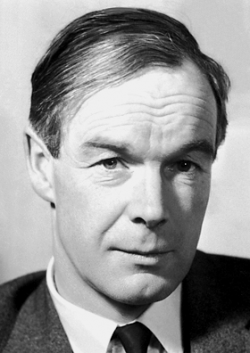Sir Alan Hodgkin

- Born
- 5 February 1914
- Died
- 20 December 1998 (age 84)
Sir Alan Lloyd Hodgkin was the definition of an eminent scientist. His achievements included presidency of the Royal Society, mastership of Trinity College, Cambridge and a knighthood. In 1963, he was also one of three scientists awarded a prestigious Nobel Prize in Physiology or Medicine.
Sir Alan’s scientific career started at Trinity College, Cambridge, where he was made a Fellow in 1936. By chance, he discovered the stimulation of a nerve at any point along the fibre causes the electrical signal to pass to the next point along the nerve. This was known as local circuit theory.
In 1937, Hogdkin received an invitation to work for a year in a laboratory at the Rockefeller Institute in New York. Here he met fellow scientist Kacy Cole who had started using squid nerve fibres (axons) in his experiments. At 0.5 mm across, these axons were large enough to use in experiments on how nerves conduct messages. This was an important discovery and was very useful to Hodgkin in his later work.
Hogdkin returned to Cambridge and began ground breaking experiments showing how nerve fibres react to electrical stimulation, even when the level of stimulation is not high enough to cause the nerve to become properly excited. He also worked out that the movement of ions (molecules with an electrical charge) into and out of nerves causes the movement of the electrical signal.
In summer 1939, Hodgkin worked at the Marine Biological Association in Plymouth where he started experiments using squid nerve fibres. His nervous system studies were interrupted by the Second World War and he was recruited as a scientific officer for the Air Ministry. Even here, Hodgkin made his mark. He was a member of the team who developed radar used by planes flying at night.
At the end of the war, Hodgkin discovered that the laboratory in Plymouth had been badly bombed, so further experiments had to wait until summer 1948. The Plymouth team were first to use mathematical models to understand biology. Hodgkin worked with Andrew Huxley and it was this work that won them the Nobel Prize in Physiology or Medicine.
Research in neurophysiology is much more like paddling a small canoe on a mountain river.
During his Nobel banquet speech, Hodgkin gave an insight into his research experience, “Research in neurophysiology is much more like paddling a small canoe on a mountain river. The river which is fed by many distant springs carries you along all right though often in a peculiar direction. You have to paddle quite hard to keep afloat. And sooner or later some of your ideas are upset and are carried downstream like an upturned canoe.”
Described as one of Britain’s most distinguished biologists, Hodgkin was knighted in 1972. Sir Alan helped us understand how nerves work. He also set the benchmark for achievement in biology and showed us what can happen when an intelligent mind embraces a chance discovery.
This page was written by a Biology: Changing the World volunteer.



